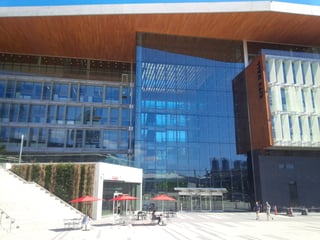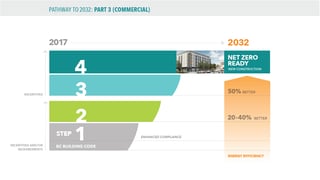Building Beyond Compliance – Why BC Energy Step Code is Your Next Step
The BC Step Code, British Columbia’s stretch Energy Code, is a performance-based standard that establishes a set of voluntary, incremental and measurable requirements for energy efficiency in New Construction.
The Step Code’s goal is to standardize stretch code requirements across the province, help bridge the gap from BC Building Code compliance to Net Zero, and take measured steps in reaching the goal of all new construction across the province to be “net zero energy ready” by 2032.

The BC Step Code was first introduced in April of 2017. British Columbia’s authorities having jurisdiction are able to begin enforcing Step Code requirements on December 15, 2017.
What is in the Step Code?
The Step Code sets out performance limits in heating (TEDI) and total energy (EUI), and includes considerations for Energy Modelling, On-site Airtightness Testing, and Building Envelope performance.
Examples of requirements you could see under the Step Code include:
Whole Building Energy Modelling: Modelling is required to assess compliance with the EUI and TEDI performance limits, and can also be used to explore a range of design options towards meeting those targets.
- Modelling must be completed prior to construction to demonstrate to local building officials that the building’s modeled design meets or exceeds the requirements defined by the code for the building type and climate zone.
- After construction, documentation that the building meets the specifications set out in the energy model must be completed and submitted to code officials.
On-site Airtightness Testing: Airtightness Testing is required for all new buildings, and all building types, prescribing to the Step Code. Testing must be conducted prior to occupancy and must meet the expectations set at the beginning of the project.
- Paying attention to detail during the construction process to reduce and eliminate gaps in the building’s air barrier is key to a successful test.
- There are no required levels of airtightness that must be met at this time, the requirement states only that the test must occur and that the results be reflected in the final energy model.
Building Envelope: New projects must include design and installation of a high-quality building envelope that includes a continuous air barrier and minimizes thermal bridges.
- By focusing on a high-quality envelope, which manages the air that moves between indoors and outdoors, the energy needed for heating and cooling is reduced and will require less energy from equipment and systems.
Step Code Metrics Research Report

Morrison Hershfield worked with an interdisciplinary technical advisory team to conduct research and analysis, providing BC Housing, BC Hydro and BC Building and Safety Standards with input to inform development of the Step Code on Energy Analysis and Costing, Energy Modelling, the Building Envelope and Airtightness Testing.
Questions about the BC Step Code or want to know how the code could affect your project specifically? Feel free to reach out to our team! Or join us at the Engineers & Geoscientists of British Columbia Annual Conference on October 20 in Whistler, where Morrison Hershfield’s Christian Cianfrone will speak on the panel 'The BC Energy Step Code: What Engineers and Geoscientists Need to Know Today'.
Not in British Columbia? Stay tuned for the next blog posts in our Energy Code Series, including an overview of the Toronto Green Standard and updates to the City of Seattle Energy Code.
Posts by Topic
Topics
- 5G (1)
- ACEC (3)
- Active Transportation (5)
- AFP/P3 (6)
- Alberta (5)
- Anniversary (1)
- approvals (1)
- Architect (2)
- Atlanta (2)
- Awards (62)
- Biophysical Sciences (1)
- Board of Directors (1)
- Bridge Rehabilitation (3)
- Building and Facilities Engineering (2)
- Building Energy (25)
- Building Envelope (48)
- Building Science (65)
- Calgary (2)
- Canada 150 (1)
- Canstruction (2)
- Capabilities (1)
- Carbon emissions (2)
- Carbon Pathfinder Tool (1)
- Carson Awards (5)
- Charity (13)
- Climate Adaption (7)
- climate change (7)
- Code and Life Safety (8)
- Commercial Buildings (4)
- Commissioning (11)
- Construction (2)
- Construction Administration (5)
- Consulting Engineering (1)
- Critical Facilities (33)
- CSR (24)
- Culture (5)
- Dallas (1)
- Data Center (22)
- Data Center Commissioning (9)
- Data Center Design (12)
- design (9)
- Design Build (1)
- DSSP (1)
- edgecomputing (1)
- edgetechnologies (1)
- Edmonton (4)
- Electrical (24)
- Electrical engineering (8)
- Energy (8)
- Engineers Canada (5)
- Environmental (36)
- Environmental Compensation (1)
- Environmental Impact Assessment (3)
- environmental planner (3)
- Environmental Planning (5)
- ETFE (1)
- Event (12)
- Existing Buildings (6)
- Facade Engineering (4)
- Ferry Docks (2)
- FIDIC (3)
- fisheries biologist (1)
- Flood Mapping (1)
- Florida (1)
- Forensic Investigation (1)
- Fundraising (11)
- garage (2)
- Gender Diversity (8)
- Gender Intelligence (3)
- Geometric Design (2)
- Government (14)
- Hospitality (1)
- Houston (4)
- Hydro (2)
- India (1)
- industrial (4)
- Infrastructure (28)
- Innovation (1)
- interchange (1)
- IWD (2)
- IWD2021 (1)
- Land Development (8)
- Landfill (4)
- Manitoba (1)
- MCF (3)
- Mechanical (21)
- Mechanical Engineering (1)
- MEP (1)
- mission critical (10)
- Moncton (1)
- Motivational MH'er (1)
- Multi-Use Pathways (1)
- Municipal Infrastructure (5)
- municipal solid waste (2)
- MUP (1)
- New Brunswick (1)
- New Hire (17)
- New Role (3)
- Newsroom (121)
- northern communities (2)
- NVTC (2)
- ontario (1)
- Operations Consulting (8)
- Ottawa (2)
- Panel (3)
- People (124)
- Project Management (6)
- QAP (1)
- Rail (1)
- Reconstruction (1)
- regulatory (1)
- Renewable Energy (2)
- resiliency (3)
- Risk Management (1)
- Roads and Highways (3)
- Salt Lake City (1)
- Seattle (1)
- Security (4)
- Social Responsibility (30)
- Solid Waste (11)
- solid waste management (5)
- St Johns (2)
- Stantec (1)
- Structural (14)
- Sustainability (23)
- Telecom (9)
- Texas (1)
- Toronto (13)
- towers (1)
- Traffic Assessment (2)
- Transfer Station (1)
- Transit (13)
- Transit Consultant (3)
- Transit Infrastructure (3)
- Transit Planning (2)
- Transportation (30)
- Transportation Engineering (8)
- transportation structures (2)
- TTC (1)
- Vancouver (6)
- Virginia (2)
- Washington DC (3)
- Waste to Energy (2)
- Water & Wastewater (8)
- Water Resources (3)
- wellfield (1)
- wellness challenge (1)
- Whistler (1)
- Whitehorse (1)
- Wireless (2)
- Women in Engineering (5)
- Yukon (5)
